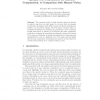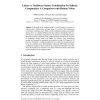13 search results - page 1 / 3 » Optimal Cue Combination for Saliency Computation: A Comparis... |
IWINAC
2007
Springer
13 years 10 months ago
2007
Springer
The computer model of visual attention derives an interest or saliency map from an input image in a process that encompasses several data combination steps. While several combinati...
DAGM
2006
Springer
13 years 8 months ago
2006
Springer
In the heart of the computer model of visual attention, an interest or saliency map is derived from an input image in a process that encompasses several data combination steps. Whi...
NIPS
2007
13 years 6 months ago
2007
The classical hypothesis, that bottom-up saliency is a center-surround process, is combined with a more recent hypothesis that all saliency decisions are optimal in a decision-the...
ETRA
2008
ACM
13 years 6 months ago
2008
ACM
Under natural viewing conditions, human observers use shifts in gaze to allocate processing resources to subsets of the visual input. There are many computational models that try ...
MM
2006
ACM
13 years 10 months ago
2006
ACM
Human vision system actively seeks interesting regions in images to reduce the search effort in tasks, such as object detection and recognition. Similarly, prominent actions in v...


